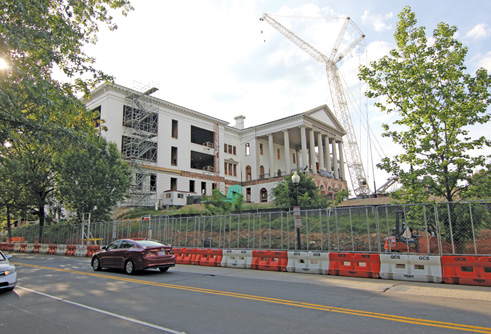Audit Details Cost Overruns at Ellington

By Mark LiebermanCurrent Staff Writer
A 2015 report from the D.C. auditor looked into why the Duke Ellington School of the Arts modernization project had gone $107 million over its allotted $78 million budget. A new auditor report released yesterday added new details, linking the budget woes to a failure of city agencies to consult with the D.C. Council.
The report notes that agencies considered two alternative sites for creating a modernized facility for Ellington before deciding to keep the arts magnet school at its existing Burleith location — where, according to the latest schedule, the renovation will wrap up in time for the upcoming school year. Both the Ellington Field, three blocks from the school at 38th and R streets NW, and the Logan School, at 215 G St. NE near Union Station, came up as possible new locations, but agencies didn’t give the public or the council an opportunity to review them before deciding to build on the existing Ellington school site, according to the report.
“I think that such a major decision as where to locate a citywide performing arts school was not publicly debated and thoroughly vetted by the council is pretty surprising,” D.C. auditor Kathy Patterson told The Current in an interview Tuesday. Her latest report — the third of its kind on school modernizations — represents her attempt to make up for her office’s failure to produce such annual reports as mandated in 2006 legislation.
Agencies nixed the Ellington Field possibility following community opposition, according to the report. But a major lingering question the report leaves unanswered is why then-Mayor Vincent Gray and D.C. Public Schools Chancellor Kaya Henderson rejected the Logan School site. Patterson told The Current she thinks Gray and Henderson could answer that question, but the answer is nowhere else to be found.
“We weren’t able to track down any discussion or minutes or emails or reports that said, ‘Here’s why,’” Patterson said. “Our point is that it’s not part of the public record.”
Though exceeding the budget by $100 million seems high to many observers, the report suggests that the council might have approved a $178 million project had it been presented that way before work got underway. But the “piecemeal approach” to completing the work indicates mismanagement, according to the report.
The latest audit also points out that the amount of square feet of performance space per student at the new Ellington school — approximately 466 — far exceeds averages for similar schools in urban districts nationwide, which range from 136 to 240. The report says the council might have suggested an alternative, more cost-effective approach to this aspect of the project if legislators had the chance to review it in advance.
After laying out its findings, the auditor’s report calls for greater transparency from agencies on project costs, a more comprehensive system of policies and procedures for modernization projects, and the completion of “education specifications” for modernization projects before they can be included in the city’s Capital Improvement Plan.
The Department of General Services provided responses to several of the report’s claims within the text of the report. The agency plans to consult multiple management firms about school modernizations in the future, rather than only one. Other refinements of agency procedures are also in the works, according to the report.
A spokesperson of the agency was unable to respond to questions yesterday afternoon, and officials at the council’s Committee on Education did not respond to a request for comment in time for publication.
Patterson plans to continue releasing one audit each year and, with the Ellington report, to closely monitor agencies’ responses. The promises of improvement from the Department of General Services is a strong first step, she said.
“To the extent that the council weighs in on the need to have greater cost consciousness, I think the agencies will comply,” Patterson said.
This article appears in the June 1 issue of The Georgetown Current newspaper.





